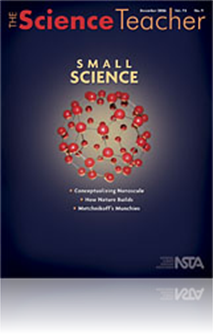All The Science Teacher resources
Journal Article
We have all sat in classes in which a teacher made a difficult or abstract concept understandable by using an analogy. Science classes are full of abstract or challenging concepts that are easier to understand if they are related to something from ou...
Journal Article
Classroom Applications of Top-Down & Bottom-Up Processing
Recent research in cognitive neuroscience has yielded a more comprehensive understanding of brain function. The advances in neuropsychological research have greatly added to our understanding of top-down and bottom-up processing. However, top-down an...
Journal Article
Editor’s Corner: Small Science
We know that nanotechnology offers real possibilities. It already appears in commercial products such as computers, sunscreens, high-performance sporting equipment, and stain-resistant fabrics. The evolution from vacuum tubes to transistors and high-...
Journal Article
The National Center for Learning and Teaching Nanotechnology (NCLT) based at Northwestern University is developing “nanoconcept” materials to bring nanoscience into the classroom. These materials center around key new concepts in nanoscience, inc...
Journal Article
Fats, Oils, and Colors of Nanoscale Materials
Phase changes and intermolecular forces are important physical science concepts but are not always easy to present in an active learning format. This article presents several interactive activities in which students plot the melting points of some fa...
Journal Article
The Structures and Properties of Carbon
The four main forms of carbon—diamond, graphite, buckyballs, and CNTs—are an excellent vehicle for teaching fundamental principles of chemical bonding, material structure, and properties. Carbon atoms form a variety of structures that are intrins...
Journal Article
Commentary: Putting Nanotechnology Under the Microscope
Nanotechnology is all over the news: Particles that become translucent or change color according to size! Particles smaller than viruses in the shape of hollow soccer balls! Particles that can destroy tumors, prevent sunburn, and keep your windows cl...
Journal Article
Self-Assembly: How Nature Builds
Self-assembly or spontaneous assembly is a process in which materials build themselves without assistance (Goodsell 2000). Presented here is a simple in-class exercise that underlines the basic principles of self-assembly and helps students understan...



